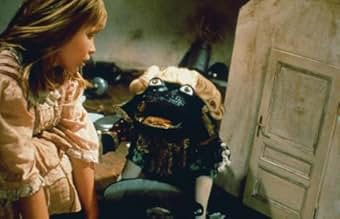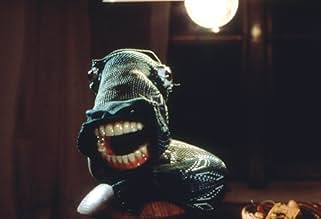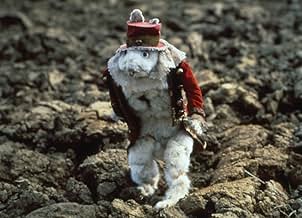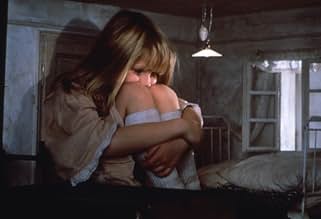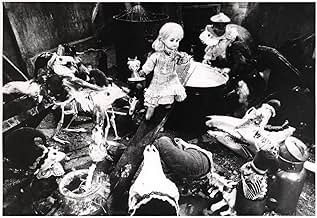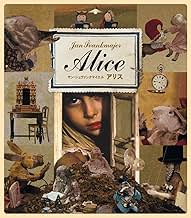CALIFICACIÓN DE IMDb
7.4/10
15 k
TU CALIFICACIÓN
Una revisión surrealista de Alicia en el país de las maravillas.Una revisión surrealista de Alicia en el país de las maravillas.Una revisión surrealista de Alicia en el país de las maravillas.
- Dirección
- Guionistas
- Elenco
- Premios
- 1 premio ganado y 1 nominación en total
Camilla Power
- Alice
- (English version)
- (voz)
- Dirección
- Guionistas
- Todo el elenco y el equipo
- Producción, taquilla y más en IMDbPro
Opiniones destacadas
Watched this last night - one of my favorites, especially as and ex-art student. He animated everything from socks to lumps of meat. Very dark, and would have been darker yet without the little girls voice over. My favorite scene, I think, is when the water rat sets up camp on her head. There is a lot to watch out for in this film, a hundred little touches, and references. Follows the book to a certain extent, but goes its own lunatic-asylum way. If you have very vivid dreams and wake up in the morning wondering 'what the heck was that all about?', it is a bit like watching this film:)
This movie may be labeled frustratingly plotless by some, and that's fair, but the imagery in this strange combination of stop-motion animation and live footage is so hauntingly rich and evocative that you get the feeling that someone has secretly filmed your own childhood dreams and translated them into Czech - perhaps for the viewing pleasure of the former commissars. The basic idea is that all of ALICE IN WONDERLAND is occurring in Alice's house, and a staggering variety of household items are animated into jerky sort of life, while all the character voices - Mad Hatter, Queen of Hearts, White Rabbit - are spoken by Alice. Alice's house, however, is a Czech house, and the items are old even by Soviet bloc standards. It's as if an antique rummage sale suddenly sprang to life to act out a monstrous little comedy for one girl. And the architecture is simultaneously comforting and frightening. Windows, for example, merely open onto other rooms, all lit by bare light bulbs. What keeps the thing tied to Lewis Carroll is the performance of the little girl playing Alice. She appears to be about six or seven, and despite the disturbing events going on around her, she never appears frightened, and always investigates events as they grow curiouser and curiouser with a determined pluck. This little girl is always in control. What this adaptation lacks in forward momentum or narrative drive it makes up for with a surreal poetry of the domestic space as dreamed by a child.
The Alice books are one of the two richest works of literature yet produced. Of the best literature, Alice lends itself to cinematic reinterpretation. And this filmmaker has vision.
But Alice is a coherent work, following the 'apprentice' novel and having kabbalistic structure. This film is episodic, each episode conceived as a different world, connected only by doors. The stories establish an abstract world, a world of logic so pure that the weaknesses of logic are apparent. That's only in part attempted here.
Though in Czech, there is some dainty wordplay: Alice is messing about in her drawers. Initially, these contain drawing equipment, later scissors. The filmmakers' signature 'large person in small room' image is used here in the episode where 'Maryanne' (Alice plus her 'house) is attempted entry by Bill the lizard, Dodgson's image of sperm. Bill is mirrored later in the frog-footman, heavily phallic as is an introduced sequence where the feet themselves become penile, then advisory.
Svenkmajer understands the cards as Tarot, a seldom understood insight and adds a vignette of the March Hare and Hatter playing cards (almost certainly a nod to 'Seventh Seal'). There's some very good visual handling of inside/outside ambiguities, and stage/reality shifting -- this alone makes this project worth sharing. But aside from that, it seems that the magic of Alice's world has yet to be tapped by a filmmaker.
Note: in Carroll's vision, innocence trumps all: logic is seen as manmade and fallible. In this world confabulated reasoning threatens but no one really loses their head. Not so in Svenkmajer's bleak world. Heads really are lost. Innocence is at least dumbfounded and possibly unreal (those socks). Many heads are already decayed with only the skull remaining. Some beings are composed of empty skulls alone or with some ambulatory object. This is not a happy man, nor a world with any sunshine. I would not give these images to any child.
But Alice is a coherent work, following the 'apprentice' novel and having kabbalistic structure. This film is episodic, each episode conceived as a different world, connected only by doors. The stories establish an abstract world, a world of logic so pure that the weaknesses of logic are apparent. That's only in part attempted here.
Though in Czech, there is some dainty wordplay: Alice is messing about in her drawers. Initially, these contain drawing equipment, later scissors. The filmmakers' signature 'large person in small room' image is used here in the episode where 'Maryanne' (Alice plus her 'house) is attempted entry by Bill the lizard, Dodgson's image of sperm. Bill is mirrored later in the frog-footman, heavily phallic as is an introduced sequence where the feet themselves become penile, then advisory.
Svenkmajer understands the cards as Tarot, a seldom understood insight and adds a vignette of the March Hare and Hatter playing cards (almost certainly a nod to 'Seventh Seal'). There's some very good visual handling of inside/outside ambiguities, and stage/reality shifting -- this alone makes this project worth sharing. But aside from that, it seems that the magic of Alice's world has yet to be tapped by a filmmaker.
Note: in Carroll's vision, innocence trumps all: logic is seen as manmade and fallible. In this world confabulated reasoning threatens but no one really loses their head. Not so in Svenkmajer's bleak world. Heads really are lost. Innocence is at least dumbfounded and possibly unreal (those socks). Many heads are already decayed with only the skull remaining. Some beings are composed of empty skulls alone or with some ambulatory object. This is not a happy man, nor a world with any sunshine. I would not give these images to any child.
Animation legend Jan Svankmajer applies his distinctive style to Lewis Carroll's most famous creation, crafting one of the most original and unforgettable takes on Alice's adventures ever put to film. Having previously adapted Carroll in his 1971 short film, "Jabberwocky," Svankmajer returns to the author's work with this amazing feature-length film. Employing a magnificent blend of live action and stop-motion animation, he uses many of Carroll's ideas as jumping-off points. Many of the characters are reconstructed as nightmarish abstracts of the way they have usually been depicted in previous adaptions. The white rabbit is a stuffed real rabbit who keeps his watch tucked in a sawdust-leaking gap in his chest. The Dormouse has been reduced to a creepy crawling foxlike hide, and the Caterpillar is a sock with eyeballs and teeth that sews its eyes shut when it sleeps. Although familiar characters such as the Mock Turtle and the Cheshire Cat are left out, Svankmajer's film is incredibly faithful to the book's sense of fantasy and absurdity. The minimal dialogue and pronounced sound effects also add to the overall unsettling mood. The key to truly appreciating this version is to forget the common associated imagery from other adaptions, and treat this as its own entity. Just as a dream makes a totally different impression on you than a person you describe it to (regardless of how well you describe it), this film is one man's surreal interpretation of another man's surreal description. The skull-headed birds, walking dolls, and broken-down furniture of Svankmajer's world make this a pretty disturbing telling of Alice's journey, but a masterful, enthralling, and undeniably unique one as well.
A mix of live action and stop-action, this arthouse flick is intriguing but bizarre. But if I was a little kid I'd be scared out of my wits by The White Rabbit with bulging glass eyeballs & long, hamster-like fangs. Socks become wood-eating worms, Alice starts eating marmalade full of tacks, a tiny mouse lands on her head, punctures it & starts a fire, the rabbit hole she falls down starts as a desk drawer that grabs her & draws her in. The Alice doll she becomes when she's shrunk is sweet but sad. I have to admit it's fascinating and 180 degrees from the saccharine sweetness of the Disney film. See it on video to experience something completely different, and probably more towards the way Lewis Carroll intended the story to be...
¿Sabías que…?
- TriviaDirector Jan Svankmajer had been disappointed by other adaptations of Carroll's book, which interpret it as a fairy tale. His aim was instead to make the story play out like an amoral dream.
- ErroresAfter testing the wooden mushroom fragments, Alice puts the piece that shrinks things in her right pocket and the other that enlarges things in the left one. In the next scene she encounters a tiny house and takes out the right hand fragment to enlarge it.
- ConexionesFeatured in Brows Held High: Alice (2011)
Selecciones populares
Inicia sesión para calificar y agrega a la lista de videos para obtener recomendaciones personalizadas
- How long is Alice?Con tecnología de Alexa
Detalles
- Tiempo de ejecución
- 1h 26min(86 min)
- Mezcla de sonido
- Relación de aspecto
- 1.37 : 1
Contribuir a esta página
Sugiere una edición o agrega el contenido que falta

